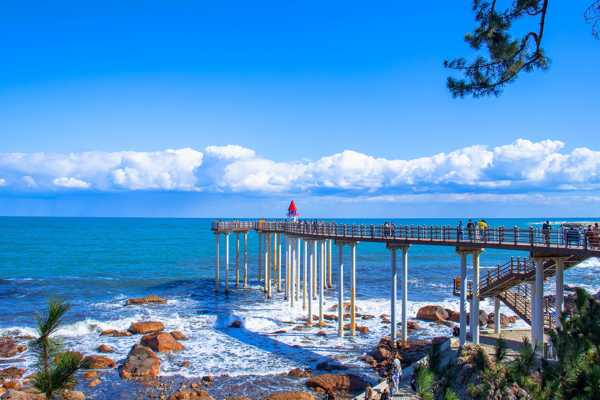The best local dishes from Pohang include outstanding seafood fare. Indeed, as the main seaport in the Daegu-Gyeongbuk region, Pohang is blessed with both breathtaking views and incredible seafood – particularly red crab.
Other popular dishes from Pohang use ingredients that extend far beyond the bounties of the sea. From juicy steamed chicken swimming in cheese and rich sauce to a humble yet nourishing rice dish commonly served as a temple meal, we have compiled some foods that you absolutely have to try whenever you are in Pohang.
- 1
Gomguk
A hearty bowl of beef soup

- 음식
Gomguk is a traditional Korean beef soup with a broth that’s typically milky white. The colour comes from the lengthy cooking time involved, which thoroughly extracts the juice and flavours from the different cuts of beef used. Gomguk is popular throughout South Korea, and Pohang is no exception. The dish is often served with rice and kkakdugi (diced radish kimchi) that adds a zing to the soup.
Some people might confuse gomguk with its close relative, seolleongtang, as both have a milky broth. The difference is the fact that gomguk exclusively uses beef cuts and is seasoned with guk-ganjang, a deep and rich soup soy sauce.
- 2
Dwaeji-gukbap
Steaming rice meets rich pork soup

- 음식
Dwaeji-gukbap is a soup dish with the side dishes added into the soup. It’s believed to date back all the way to the Korean War refugees, as the dish is nourishing yet simple to prepare. Today, however, Dwaeji-gukbap is enjoyed all over the country.
The dish features pork bone broth seasoned with sesame oil, rice wine, and soy sauce. It usually comes with a bowl of rice, kimchi, and other assortments known as banchan on the side. You can add everything into the soup, give it a good mix, and dig in. Many diners like to have some alcohol with their Dwaeji-gukbap. On a cold day, such a pairing is hard to beat.
- 3
Jjimdak
A popular South Korean steamed chicken dish

- 음식
Jjimdak is a simple yet delicious dish of steamed chicken that’s wildly popular with locals and travellers in South Korea. Chunks of juicy chicken are braised in a sweet and spicy sauce, together with potatoes, mushrooms, chilli peppers, glass noodles, and other aromatic bits and spices. Jjimdak pairs perfectly with a bowl of rice, but you can certainly enjoy it by itself or with a pint of cold beer.
Some joints in Pohang serve their own take on the popular chicken dish – extra ingredients such as cheese, rice cakes or dumplings are added into their jjimdak. It can come as a mild or spicy version so, if you are in an adventurous mood, you can turn up the heat.
- 4
Mulhoe
Tame the summer heat with this chilled soup

- 음식
Mulhoe is a cold soup featuring raw fish in a spicy broth. Pohang’s proximity to the ocean means that you are never too far from seriously tasty seafood. Mulhoe is believed to have been invented by the local fishermen in Pohang as a cure to fight hangovers and give them extra stamina while being simple enough to prepare without heat.
Mulhoe features slices of raw fish, pear slices, sesame oil, sesame seeds, and gochujang paste. The result is a must-try summer dish that revitalizes the body, is nourishing, and which is simply bursting with flavor.
- 5
Samgyetang
The go-to soup for the hottest summer days

- 음식
Samgyetang is a whole chicken soup seasoned with ginseng. The dish is usually made by boiling a whole young chicken stuffed with glutinous rice, jujube, garlic, and herbs in a medicinal broth. In South Korea, the 3 hottest summer days are known as the Boknal Days. During this scorching period, people flock to samgyetang restaurants to get their fill of this nourishing dish.
This soup is often served in a hot stone bowl and unsalted, so diners can adjust the taste for themselves by adding salt to the soup. Summers in Pohang can be sweltering, so stop by and grab a bowl of samgyetang. It is just the thing to help you stay energised during your travels.
- 6
Gwamegi
A preserved winter fish treat

- 음식
Gwamegi is half-dried herring that originates from Pohang. In the past, people were concerned about how to preserve the abundant schools of herring that would come to Yeongilman Bay to spawn in winter. The answer was to freeze-dry the herring in the frigid temperature and thaw the fish when they are about to be cooked or served as is, giving the fish a half-dried nature.
One way to enjoy Gwamegi is to wrap a piece of it in a sea mustard leaf with sliced garlic and chives. The wrap is then dipped into a soy sauce and vinegar mixture before consumption. Gwamegi is so popular in Pohang that it has an event dedicated to it known as the Pohang Guryongpo Gwamegi Festival.
- 7
Daege
A famous winter delicacy in Pohang

- 음식
Daege or snow crab is arguably one of the most famous seafood ingredients in Pohang. Lauded as exceptionally tasty, winter is the season to be on the lookout for this massive crab that is crammed with succulently sweet meat. Pohang’s snow crabs are so precious that fishmongers label the crabs caught in Pohang to distinguish them from crabs caught in other parts of the country.
The preferred way to prepare daege is by steaming the crab, ensuring that the crab’s natural flavours take centrestage. Many diners also like to take the crab’s innards out and prepare some bibimbap with them.
- 8
Jjukkumi bokkeum
Stir-fried octopus in a spicy sauce that goes great with rice

- 음식
Jjukkumi bokkeum is a dish featuring stir-fried octopus. Pohang, being a port city, is one of the prime places to enjoy some of the freshest seafoods in South Korea, and jjukkumi bokkeum is a popular way to prepare octopus. The dish usually uses baby octopus for a very tender chew.
The spicy sauce and the sweet octopus go hand-in-hand with a bowl of freshly steamed rice. Some places season their jjukkumi bokkeum extra hot, so if you can’t handle spicy food too well, it never hurts to ask for them to lower the spiciness level for you.
- 9
Gondrebap
A rustic temple dish of rice and thistle

- 음식
Gondrebap is a South Korean rice dish that’s cooked together with gondre (thistle). This dish originated in the mountainous areas throughout Korea, where Buddhist temples are usually located. Living in close touch with changing seasons, monks made the most of this wild vegetable, among other ingredients, all while practising a strict diet.
The resulting dish is a bowl of aromatic rice, often seasoned with a combination of sesame oil, soy sauce, and scallions. It is a simple and tasty dish, great for anyone in Pohang looking for a quick lunch while making sure that they are getting the nutrition their body needs.
- 10
Dotori sujebi
From winter survival food to dinnertime darling

- 음식
Dotori sujebi is an acorn pasta soup with acorn jelly swimming in beef broth. The dish originated as a way to find something to eat while enduring the harsh winters in the past. The people of North Gyeongsang, where Pohang is located, gathered acorns in the mountain. The acorns are ground into powder and made into jelly or mixed with flour to form sujebi, a kind of hand-torn pasta.
The broth for dotori sujebi is made by slowly boiling beef bones for as long as 20 hours, resulting in a hearty concoction that is perfect for a cold day. Acorn jelly and acorn sujebi are added into the broth together with mushrooms, pine nuts, ginseng, and other vegetables. It is then served with a bowl of steaming rice.



















